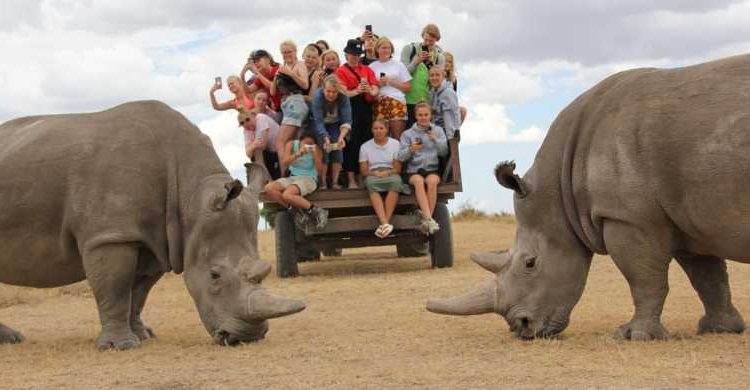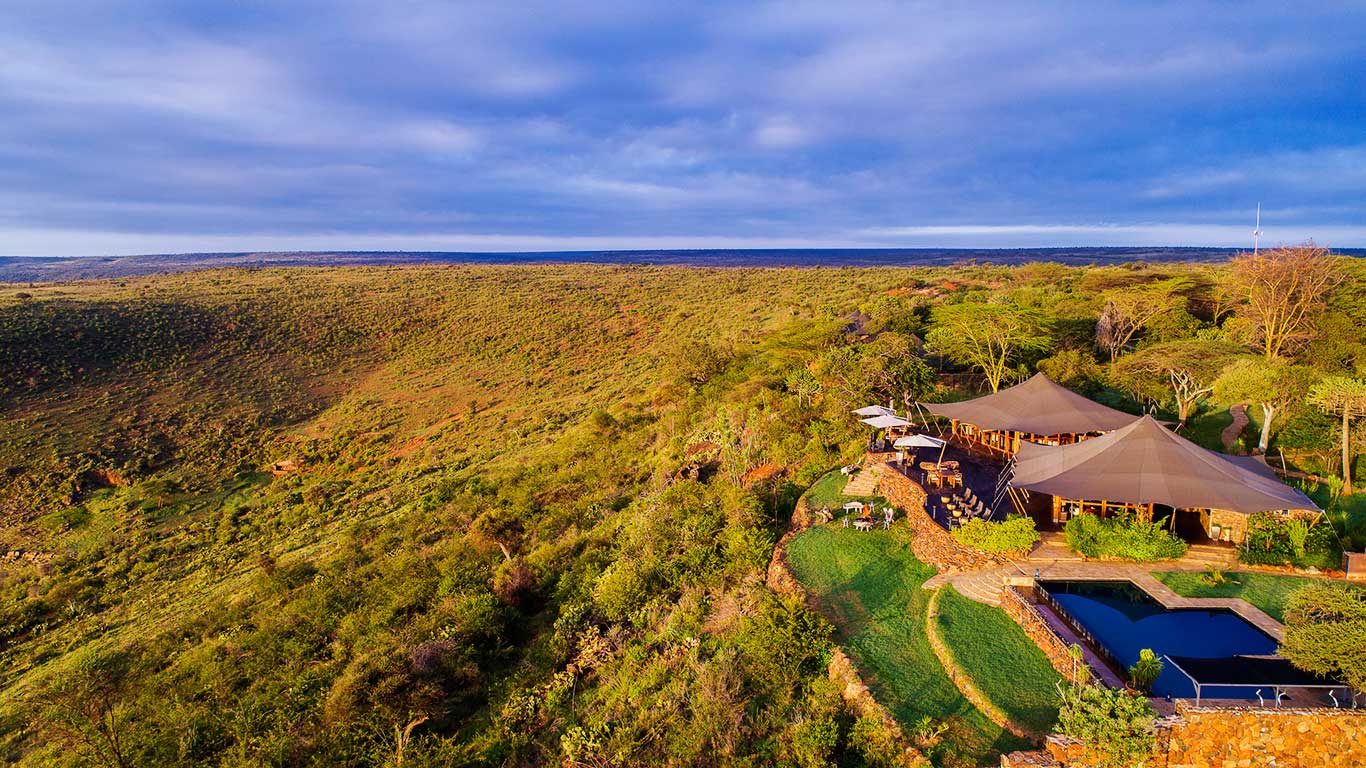Wildlife at Ol Pejeta Conservancy : The Ol Pejeta Conservancy is home to all five of the “Big five game”—the lion, African elephant, leopard, rhinoceros, and Cape buffalo. This is where black and white rhinos flourish. Ol Pejeta registered the birth of its 100th black rhino in 2013. According to the IUCN African Rhino Specialist Group classification, the Conservancy’s black rhino population is now classified as a “Key 1” population. Only eight sanctuaries in Africa can make this claim. This one is unique.

The endangered African wild dog, oryx, Jackson’s hartebeest, Grevy’s zebra, serval, cheetah, and bat-eared fox are among the other uncommon creatures that may be found on Ol Pejeta. Of course, you may also find the more common African species here, such as giraffes, baboons, hippos, eland, Grant’s gazelle, dik-dik, plains zebra, silver-backed jackal, and hyena. The Conservancy is home to more than 300 different species of birds.
Via specially built “game corridors” that solely impede the migration of rhinos, all animals are able to enter and exit the Conservancy. Elephants, antelope, and carnivores may easily jump or step over the knee-high posts in the ground that are positioned very near to one another. Nevertheless, because they lack the ability to do this, rhinos are prohibited from relocating into regions where they run the risk of being killed for their horn.
Chimpanzee Sanctuary
Ol Pejeta’s Chimp Sanctuary consists of two sizable enclosures divided in half by the Ewaso Ngiro River and is home to 39 severely injured chimpanzees that were freed from captivity in Africa and other countries. There’s an elevated observation platform, and keepers are typically available to provide a brief history of each chimp; take note of the tiny duplicate cage where one of the chimps spent years on end being chained before being transported to the sanctuary.
If you would like to support the sanctuary, there is an information centre and you may adopt a chimp for between $100 and $250 US.
Solio Ranch
Located in Kenya’s Central Province, Solio Ranch, also known as Solio Game Reserve, is a privately owned wildlife conservation area.
The ranch is a gated, privately held sanctuary dedicated to the preservation of rhinoceros. The 17,500-acre reserve, which is located 22 km north of Nyeri Town, is Kenya’s oldest rhino sanctuary and a significant black rhino breeding centre. It is vital to the preservation and breeding of black rhinos in Kenya. One of the “Big-Five,” a popular tourist destination, is the rhino. One of Kenya’s most prosperous private rhino breeding areas is Solio Ranch. The animals coexist peacefully with other species, which includes giraffes, buffalo, zebras, and plains game like waterbucks, eland, oryx, impala, and Thompson’s gazelles. There were 635 black rhinos and 353 white rhinos in Kenya’s various conservation areas at the end of 2009.
Self-drive safaris are allowed, and although not required, having a Solio guide (KSh500) along is beneficial.
Rhino sanctuary
A new management plan for Kenya’s black rhino conservation was adopted in March 2003 by the Kenya Wildlife Service (KWS).The remaining rhinos from national parks and reserves as well as those from private land were to be utilised to finish populating new sanctuaries in both sectors. According to the Kenya Wildlife Service, in order to produce and retain a genetically viable population of black rhinos belonging to the East African race or subspecies in their natural habitats in Kenya, it is imperative that a high and sustainable yearly growth rate be maintained. This was to be achieved by giving biological management and law enforcement more focus.
How to get to Laikipia Plateau
It is possible that you are wondering how to go from Nairobi to the Laikipia Plateau. Your all-inclusive visit to this beautiful location can be arranged with Focus East Africa Safaris. The Laikipia Plateau can be reached using these directions.
The Laikipia Plateau is a vast area that stretches along the Northern Kenyan Frontier, encompassing the heights of Mount Kenya and the edge of the Great Rift Valley.
A mosaic of interconnected ranches and undulating red plains define Kenya’s Laikipia Plateau. Along with excellent game viewing and a plethora of family-friendly activities, the area boasts a diverse selection of gorgeous lodges, each one distinctive in its own right. Laikipia is a destination in and of itself, but it’s frequently included in itineraries as an addition to a safari in the neighbouring Masai Mara.
Thus, there are two ways to get to the Laikipia Plateau: by air and by road.
By Road
Depending on which reserve you are visiting, the travel to the plateau from Nairobi takes four to eight hours, and from Lake Nakuru, it takes three to seven hours. You will have an amazing experience of the countryside after the road trip.
By Air
The majority of travellers to Laikipia come from Nairobi or neighbouring parks by private charter. The closest town, Nanyuki, is where you may also charter a plane. There are airstrips in every Laikipia reserve. Nairobi is one of the major transportation centres in Africa. Jomo Kenyatta International Airport (NBO), located 15 km/9 mi southeast of Nairobi, is the destination for international flights.
There are three primary airstrips in this large area: Lewa Downs, Nanyuki, and Loisaba. The most popular route is arriving by plane from Nairobi and connecting to the Mara; the majority of the lodges are located within an hour of an airstrip. The airstrip to close the lodge or reserve that you are seeing on your schedule will be your choice.
Accommodations in Laikipia Plateau
There are many lodges and lodging alternatives available to visitors searching for places to stay in the Laikipia Plateau, ranging from luxurious accommodations to community homestays. The lodgings are scattered among the conservancies. It is essential to align your itinerary with accommodations near the conservancy you wish to visit for optimal planning.
Lewa Safari Camp
Lewa Safari Camp offers genuine comfort to its guests with spacious tented bedrooms with verandah and full en-suite bathrooms; warm log fires in the living area are ideal for unwinding after a day in the Conservancy. Sixty-five thousand acres of exclusive, protected wilderness are accessible to guests of this exceptional and exclusive hideaway. The only lodging establishment in the Conservancy that is owned by the Conservancy is Lewa Safari Camp. Lewa Wildlife Conservancy directly invests its profits and conservancy fees back into community programmes and conservation activities. One of the most popular locations to stay on the Laikipia Plateau is here.
Loisaba Tented Camp
Loisaba Tented Camp is situated atop an escarpment, offering unobstructed views of Laikipia’s varied terrain, extending as far as Mount Kenya. Every room and the common rooms provide an amazing view of a wide-open landscape. The essence of Loisaba Tented Camp is luxury and flair with an African feel. Built to order, the spacious and airy tents have high ceilings, polished wood flooring, and big floor to ceiling doors and windows. The stylish Africana furniture in the tent suites has a contemporary European feel to it.

Porini Rhino Camp
In the prestigious 90,000-acre Ol Pejeta Conservancy in Laikipia, Kenya, is Porini Rhino Camp. There are six roomy guest tents in the camp, each with a private bathroom and comfortable furnishings. With no generator and solar-powered illumination, the camp is ecologically sustainable. Sundowners, bush walks, night time game drives, and open-air 4×4 game drives with knowledgeable guides are all included. On game drives from the camp, all five of the Big Five have been sighted.
Sabuk Lodge
With a view of the Laikipia Plateau and Samburu territory, Sabuk Lodge is a breathtaking wilderness getaway located in the Northern Frontier District on the high banks of the Ewaso Nyiro River. In addition to Eagle house, a family house with two en suite bedrooms, a sitting room that connects, and a private swimming pool, the lodge offers six exquisitely decorated open-sided en suite cottages. Each of the cottage’s rooms and the lodge rooms has an amazing view.
Segera Retreat Lodge
Segera is the right destination if you want to embrace a fresh perspective on how humans interact with the natural world and re-establish a connection with the natural world. Known as the entry point to Kenya’s wilderness, we provide you with first-rate private service in a distinctive haven. Six homes made of wood and thatch surround an abundance of flora in the beautifully designed gardens, and from their elevated wooden platforms, they look out over the savannah. More seclusion, elegance, and breathtaking views can be found at the immaculate Segera House and the well situated Villa Segera.
Kicheche Laikipia camp
Kicheche Laikipia is an eco-award-winning, opulent, tiny tented camp with a view of a waterhole, set at the base of an indigenous forest and beneath the shadow of Mount Kenya. Squeaky green safari style from the camp blends delicately and elegantly with the natural highs of Ol Pejeta’s wilderness zone.
Ol Pejeta Bush Camp
The surrounding Ol Pejeta Bush Camp, owned by Alex Hunter, offers the pinnacle of Kenyan hospitality and safari quality. It is located in the Laikipia district of central Kenya, on the banks of the Ewaso Nyiro River. The final three northern white rhinos left in the world will coexist with you in this area. The six classic East African safari tents at Ol Pejeta provide a great starting point for discovering the mysteries of this well-known conservancy, from the ground-breaking conservation initiatives that have made it well-known to the breathtaking sightings of black and white rhino and the Big Five. For seasoned safari travellers desiring to experience and comprehend the pinnacle of global best practices in conservation, Ol Pejeta is the obvious choice.


